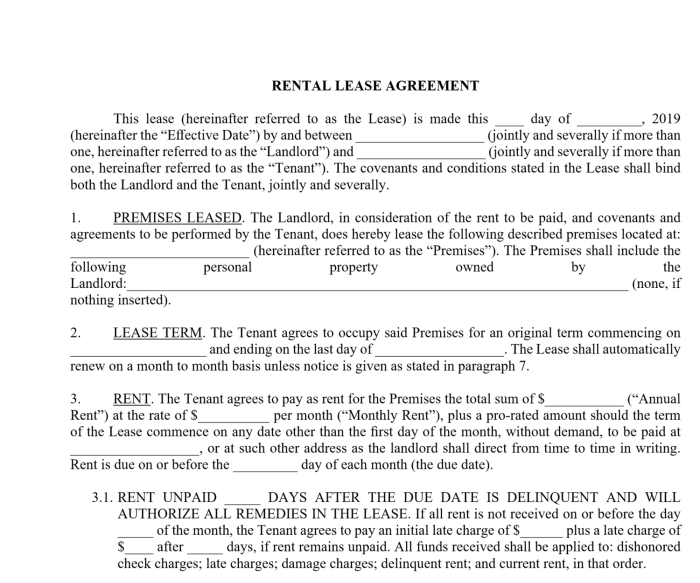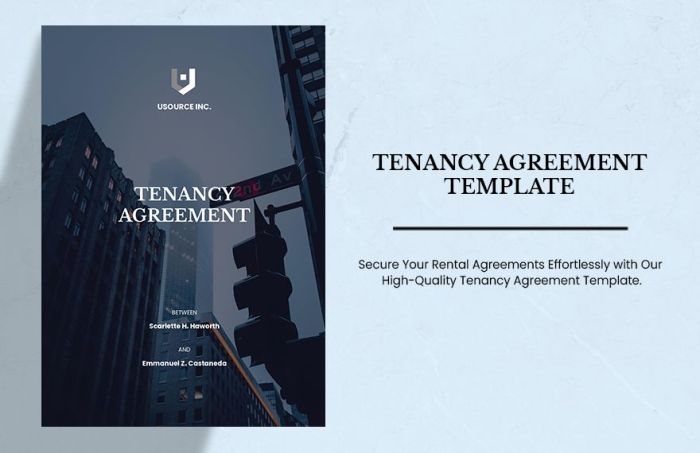House Rent Contract Format A Comprehensive Guide
Essential Clauses in a House Rent Contract
House rent contract format – A well-drafted house rent contract protects both the landlord and the tenant. Including specific clauses ensures clarity and minimizes potential disputes. This section Artikels key clauses that should be present in any comprehensive rental agreement.
Detailed Property Description
A detailed property description is crucial for avoiding misunderstandings. This should include the property’s address, a precise description of the included rooms and amenities (e.g., number of bedrooms and bathrooms, appliances included, parking spaces), and any unique features. Photographs are also highly recommended as supplementary evidence. Ambiguity in the description can lead to disputes later on, especially regarding the condition of the property upon move-in.
Rental Period and Renewal Options
The contract must clearly state the rental period (e.g., “a one-year lease commencing on October 1, 2024, and ending on September 30, 2025”). It should also detail the process for renewal, including whether the lease automatically renews, the notice period required for either party to terminate or renew, and any changes in rental rates for the renewed period. For example, a clause might state: “This lease will automatically renew for another year unless either party provides written notice of termination at least 60 days prior to the expiration date.
The rent for the renewal period will be subject to a 5% increase.”
Payment Terms
Payment terms should specify the amount of rent, the due date, and acceptable payment methods (e.g., check, online transfer, money order). The contract should also Artikel the consequences of late payments, including the amount of late fees (e.g., a $50 late fee after 5 days). For example, a clause might state: “Rent of $1500 is due on the first day of each month.
A late fee of $50 will be charged for any payment received after the 5th of the month.”
Security Deposits and Return Conditions
This clause should clearly state the amount of the security deposit, how it will be held (e.g., in an escrow account), and the conditions under which it will be returned. It’s vital to Artikel the process for inspecting the property at the end of the tenancy and deducting any costs for damages beyond normal wear and tear. A sample clause could state: “A security deposit of $1500 is required.
This deposit will be held in an escrow account and returned within 30 days of the lease termination, less any deductions for damages beyond normal wear and tear, as mutually agreed upon in a final property inspection report.”
Property Maintenance and Repairs
This section should Artikel the responsibilities of both the landlord and the tenant regarding property maintenance and repairs. It should specify who is responsible for different types of repairs (e.g., the landlord is responsible for major repairs like roof leaks, while the tenant is responsible for minor repairs like replacing a lightbulb). For instance, a clause could state: “The landlord is responsible for maintaining the structural integrity of the building, including the roof, plumbing, and electrical systems.
The tenant is responsible for maintaining the cleanliness of the property and reporting any necessary repairs promptly.”
Tenant and Landlord Responsibilities

Source: approveme.com
Clearly defined responsibilities prevent conflicts and ensure a smooth tenancy. This section details the roles of both parties in maintaining the property and upholding the lease agreement.
Tenant Responsibilities Regarding Property Upkeep and Damage
Tenants are typically responsible for maintaining the cleanliness and orderliness of the property. They should also report any damage or necessary repairs promptly to the landlord. Excessive damage beyond normal wear and tear is usually the tenant’s responsibility. The contract should clearly define what constitutes “normal wear and tear” to avoid ambiguity.
Utility Responsibilities
Responsibility for utilities can vary depending on local customs and the specific property. Some leases assign all utility responsibility to the tenant, while others may include certain utilities in the rent. The contract should clearly specify which utilities are included in the rent and which ones are the tenant’s responsibility. For example, the lease might state that water and trash removal are included, while electricity and gas are the tenant’s responsibility.
Guest Access and Pet Policies
The contract should Artikel any restrictions on guest access (e.g., limitations on the number of guests or the duration of their stay) and pet policies (e.g., whether pets are allowed, any breed restrictions, or pet fees). Clear guidelines prevent misunderstandings and potential conflicts.
Tenant and Landlord Duties Summary
| Responsibility | Tenant | Landlord |
|---|---|---|
| Rent Payment | Pay rent on time | Provide a receipt for rent payment |
| Property Maintenance | Maintain cleanliness, report repairs | Handle major repairs, ensure habitability |
| Utilities | Pay for specified utilities | Pay for specified utilities (if applicable) |
| Damage | Responsible for damage beyond normal wear and tear | Ensure property is in habitable condition at the start of the lease |
Subletting Clauses
Subletting clauses specify whether the tenant is allowed to sublet the property or rent it out to another party. If permitted, the clause will detail the process and any necessary approvals from the landlord. Restrictions on subletting are common to protect the landlord’s interests.
Termination and Breach of Contract
This section details the process for ending the lease agreement and the consequences of violating the contract’s terms.
Early Termination Process
The contract should clearly Artikel the process for terminating the lease early. This usually involves a written notice period (e.g., 30 or 60 days) and potentially a penalty or early termination fee. The specific terms will vary depending on the jurisdiction and the lease agreement.
Breach of Contract Clauses, House rent contract format

Source: template.net
Understanding the specifics of a house rent contract format is crucial before signing. This includes carefully reviewing clauses regarding rent, utilities, and lease duration. If you’re looking for properties, you might find suitable options by checking out available houses, such as those listed on this site for house for rent in Sacramento, CA. Remember, a well-drafted contract protects both landlord and tenant, so always read thoroughly before committing.
This section defines actions that constitute a breach of contract by either party. Examples include non-payment of rent, property damage beyond normal wear and tear, or violation of specific lease terms (e.g., unauthorized pets or subletting). Consequences for breach of contract might include termination of the lease, legal action, and financial penalties.
Consequences of Violating Contract Terms
Consequences for violating contract terms should be clearly stated. These could include financial penalties (e.g., late fees, damages), eviction, or legal action. The specific consequences will depend on the nature of the violation and the terms of the lease agreement.
Common Reasons for Contract Termination
- Non-payment of rent
- Significant property damage
- Violation of lease terms (e.g., unauthorized pets, subletting)
- Mutual agreement between landlord and tenant
- Eviction due to legal reasons
Dispute Resolution Methods
The contract should specify a method for resolving disputes between the landlord and the tenant. Options include mediation, arbitration, or litigation. A clause might state: “Any disputes arising from this lease agreement will be first attempted to be resolved through mediation. If mediation fails, the parties agree to binding arbitration.”
Legal and Regulatory Compliance: House Rent Contract Format
Compliance with local laws is paramount for both landlords and tenants. Understanding legal requirements protects all parties involved.
Compliance with Local Housing Laws
Landlords must comply with all applicable local, state, and federal housing laws and regulations. These laws often cover areas such as habitability standards, tenant rights, and discrimination. Failure to comply can result in significant penalties.
Potential Legal Pitfalls
Potential legal pitfalls include including discriminatory clauses, failing to provide proper notice, or not maintaining the property in a habitable condition. Careful review of the contract by legal professionals is essential to avoid these issues.
Discriminatory Clauses
Discriminatory clauses based on race, religion, national origin, familial status, or disability are illegal. Including such clauses can result in significant legal consequences for the landlord.
Essential Legal Considerations
- Compliance with fair housing laws
- Proper notice requirements for rent increases or lease termination
- Maintenance of habitable conditions
- Security deposit handling and return
- Privacy rights of tenants
Role of a Lawyer
A lawyer can help ensure the contract complies with all applicable laws and regulations, protecting both the landlord and the tenant from potential legal issues. They can review the contract, suggest necessary modifications, and advise on legal implications.
Sample Contract Formats and Variations
Different rental situations require variations in contract formats. This section provides a basic example and discusses key differences.
Sample Contract Format
While a full sample contract is too extensive for this format, a simplified example using HTML tags to illustrate the structure follows:
<p>This Lease Agreement is made between [Landlord Name] (Landlord) and [Tenant Name] (Tenant) on [Date].</p><p>
1. Property
[Address]</p><p>
2. Rent
$[Amount] per month, payable on [Date].</p><p>
3. Lease Term
[Start Date] to [End Date].</p><p>
4. Security Deposit
$[Amount].</p><p>...</p>
Contract Variations for Different Property Types
Contracts for apartments, houses, and rooms will differ in detail. For example, a house lease might include clauses on yard maintenance, while an apartment lease may focus on shared amenities. Room rentals within a larger house often include clauses specifying shared spaces and responsibilities.
Short-Term vs. Long-Term Agreements
Short-term leases (e.g., less than a year) are often simpler and may have less stringent renewal processes compared to long-term leases. Long-term leases generally provide more stability for both parties but may include more detailed clauses.
Contract Modifications
A standard contract might require modification if unusual circumstances exist. For example, if a tenant requires specific accommodations due to a disability, the contract might need to include clauses addressing accessibility modifications. Similarly, if the property includes unique features or amenities, the contract should accurately reflect these.
Information Required for a Legally Binding Contract
A legally binding contract requires clear identification of the parties involved, a description of the property, the rental amount, the lease term, payment terms, and signatures from both parties. Additional clauses addressing specific needs or situations may also be necessary.
Essential FAQs
What happens if the landlord doesn't make necessary repairs?
Most jurisdictions have laws outlining a landlord's duty to maintain habitable conditions. Failure to make necessary repairs, after reasonable notice from the tenant, could give the tenant legal recourse, potentially including rent reduction or termination of the lease.
Can a landlord enter my property without notice?
Generally, no. Landlords usually need to provide reasonable notice (24-48 hours is common) before entering a tenant's property, except in emergencies or for pre-arranged inspections.
What constitutes a breach of contract by a tenant?
Breaches can include non-payment of rent, damage to the property beyond normal wear and tear, violating terms regarding pets or guests, or subletting without permission.
How long should a rental agreement be for?
The length depends on local laws and agreement between parties. Common durations include one year, six months, or month-to-month.




















